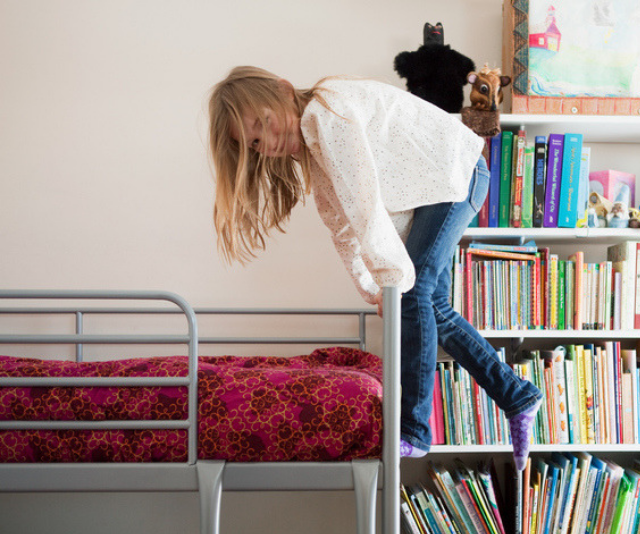The novelty of a bunk bed in your bedroom is often a childhood staple. Sharing with siblings, or hosting sleepovers, kids love a bunk!
There is also no doubt that bunk beds are a convenient space saving solution for families with multiple children and limited space, however there is significant caution that must be taken before their use.
As useful as they are, bunk beds come with an associated danger, particularly for younger children.
Are bunk beds safe?
When assembled and used with caution, bunk beds can be safe in a child’s bedroom.
There is an Australian/New Zealand product standard that applies to bunk beds AS/NZS 4220:1994. Look for a label or swing tag validating compliance. This standard is not mandatory, so consumers must be aware to check that the bunk beds they are using meet these standards themselves for peace of mind.
Cautions to take before using bunk beds:
Bunk beds are not recommended for use of children under nine years of age. Injuries involving bunk beds most commonly occur to children under the age of six.
If you are using bunk beds as a space saver, consider a regular bed and a trundle as a safer solution.
The top bunk is not a play area and should be used solely for sleeping. Falls while playing on the top bunk make up most reported injuries.
Ladders and guardrails – even if bunk bed is against a wall – must be fixed and stable.
Check regularly for wear and tear, particularly loose bolts and brackets, and repair immediately.
Bunk beds must not have any dangerous gaps that can trap a child’s head or limbs.
Make sure that the mattresses are suitable for the bunk bed in question. If you are replacing mattresses make sure you check the effect their size will have in relation to the height of the guardrail and any gap in between.
Pay particular attention when using bunk beds that are not familiar to you eg those used in holiday accommodation.
You’ll find more detail on safely positioning your bunk beds in the bedroom below.
READ NEXT: Swimming lessons save lives

Bunk beds are not recommended for use of children under nine years of age.
Common bunk bed injuries
It is estimated that, in Australia, in the under fifteen age-group, there are at least 2,100 bunk bed-related injuries treated annually by hospital emergency departments, most common in those aged between five and nine.
There have been three deaths in Australia associated with the design of bunk beds. All of these deaths occurred in 2001 and 2002 prior to the introduction of the mandatory standard. Two children aged two died due to bunk beds not having guardrails on all sides, which resulted in the children becoming trapped between the wall and bed. In the third incident, a ten year old died after falling from the top bunk and hitting her head.
Because most of these injuries occur due to the way that young children play and behave on bunk or loft type beds, their incidence can be greatly reduced with a few strongly enforced ground rules.
Continues after video …
Where to put your bunk beds
Most people have bunk beds against a wall, however, If your bunk beds can’t be flush up against the bedroom wall, then you must allow a clear space greater than 230mm right around the bed.
Bunks should never be placed against a window.
Avoid positioning bunk beds directly underneath or next to a ceiling fan or light fixture, ensure at least two metres clearance. Also check that there is ample room for your child to sit without hitting their head on the ceiling.
Bunk bed guard rails are non-negotiable!
Even if your bunk bed is positioned against a wall, ensure that all guard rails are fixed and stable on the top bunk. To avoid falls, the Australian Standard requires guardrails on all sides of the top bunk, with the top of the guardrails at least 160mm above the top of the mattress.
Make sure all nuts, bolts and other fasteners on bunk beds are flat or recessed and smooth and do not create a sharp point, edge or snag hazard.

Bunk beds must not have any dangerous gaps that can trap a child’s head or limbs.
Dangerous gaps on bunk beds
Small bodies might not be able to fit through the gaps, but body parts can and that comes with huge risk of injury and asphyxiation. Injuries to heads, arms and legs can occur if young children become trapped in gaps such as between rails and the mattress.
Ensuring that toys, books and any other sharp objects are clear from around the base of your bunk beds, reduces the risk of injury if a child is to fall.
Consider a night light for your bunk beds
To make getting in and out of the top bunk safer during the evening, having a night light or a torch handy is a great idea.
Make sure kids know not to play on bunk beds
As tempting as a good old mattress jump is, when it comes to bunk beds to risk of serious injury is simply too great.
Set and enforce strict ground rules about how your bunk beds are used and ensure your child’s bedroom is a safe haven for sleep, rather than a potential trip to the emergency room!
For further information regarding bunk bed safety visit www.productsafety.gov.au.
